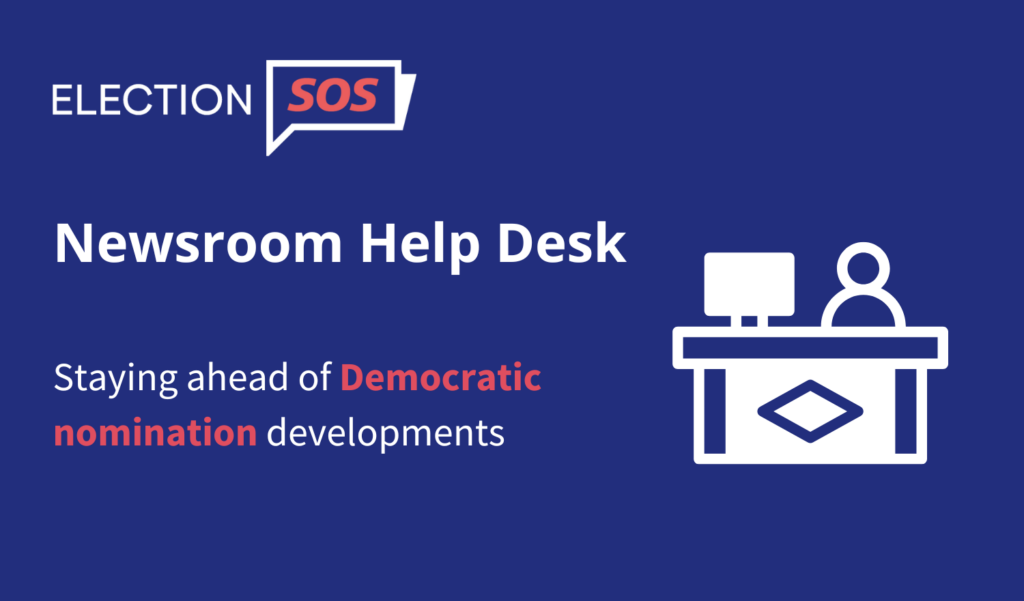
Newsroom Help Desk: Staying ahead of Democratic nomination developments
article
By Bridget Thoreson and Massarah Mikati
Updated July 30, 2024
President Joe Biden withdrawing his candidacy for the Democratic nomination weeks ahead of Chicago’s convention has upended the march toward the general election in November.
Through the twists and turns as this develops, consider this your go-to reference menu of best practices for coverage that supports democracy and empowers the electorate. We’ll keep it updated with the latest from our partners, so come back as often as you need.
My newsroom is looking for concrete, actionable info on:
- How to public-power our coverage on the latest developments in the presidential race
- Explaining what happens next to your audience
- What happens at each step of the nomination process
- Keeping tabs on mis- and disinformation
- Something else: Connect with the team at democracy@wearehearken.com. We’re in contact with dozens of journalism and civic information organizations to provide newsrooms with relevant resources to support their election coverage.
Stay updated with the latest election coverage support opportunities with our newsletter: electionsos.org/newsletter.

Access free and reduced price resources for your election coverage through the Knight Election Hub.
How to public-power coverage on the latest developments in the presidential race
The temptation to pursue horse-race reporting with Biden’s exit from the race just exploded. We’ve worked with dozens of newsrooms at Election SOS over several election cycles to build engagement and trust into their coverage, stress-testing the best approaches for resource-strapped outlets. In that time, we’ve found one guiding question that cuts through the noise to help you make coverage decisions:
“What information need will this reporting meet for the public?”
That’s the checklist. One question before you begin reporting to confirm that your work will provide valuable information for those you aim to serve.
Why is this framing so powerful? It pulls us out of the distractions of the daily news churn to focus our limited reporting resources. It ensures we work to understand what the electorate needs to know, not how we can beat someone to a post or add a hot take to a pile of similar content. And it serves as a check that our editorial strategy is being driven by the interests of those we aim to serve.
Here are the types of stories this checklist can make possible:
- Promoting civic understanding by explaining how the voting process works
-
-
- First-time voting for naturalized citizens, explained (Documented)
- 2024 California ballot measures: What you need to know (CalMatters)
-
- Holding candidates and officials responsible to address issues your community cares about
-
-
- Promise Tracker: Mayor Bass’ Progress On Homelessness, In 6 Charts (LAist)
-
- Preventing the spread of misinformation and disinformation through fact-based accounts
And here are stories that wouldn’t pass muster:
- “Check Out This New Poll on Who is Ahead”
- “Pundit Gives Opinion on Flash in the Pan Moment”
- “We Built An Entire Article Around One Sassy Soundbite”
- “Are You Curious About This Question? We’ll Ask It and Decide We Don’t Know the Answer”
- “My Editor Wanted to Post This Minor Update Before The Other Guys, Not That You Notice or Care”
If you’re not sure what your audience needs to know, simply incorporate asking into your editorial workflow. It can be as simple as tacking on a question to each interview or as ambitious as creating an agenda based on community outreach.
We believe every type of newsroom can develop more meaningful and beneficial relationships with those they aim to serve. Like all strong journalism, it starts with asking the right question.
Want more election coverage resources? Get training, funding opportunities and more delivered to your inbox.
Explaining what happens next to your audience
Some people will attempt to delegitimize the move to replace the presumptive nominee, saying it is not legal. Be sure to correct the record if you see this happening, and refer to the National Taskforce on Election Crises for more information. You can also check out this piece from Protect Democracy on how our political parties are functioning exactly the way they’re supposed to.
What happens at each step of the nomination process
The public is getting hit with a whirlwind of information. But journalists often get carried away with insider baseball coverage of the story, forgetting that one of the things readers need the most from you during this rare election event is to get back to the basics with a clear, concise explanation of the nomination process. Don’t assume your readers will catch the story you published on Sunday! We recommend pinning these articles at the top of your news outlets’ campaign coverage so readers can easily find and access the information. Here are some examples of explainers we’ve seen that we found to be helpful for the electorate:
- How Democrats can pick a new candidate, step by step
- We particularly loved the visual The Washington Post utilized for this explainer, breaking down the nomination process in a simple, digestible and engaging way.
- What happens next now that Biden has dropped out?
- From POLITICO, this Q&A article does a great job laying out the most common questions people are asking right now.
- What happens now that a presumptive nominee has dropped out?
- From the Center for Tech and Civic Life, this guide provides a handy visual for you to reference throughout your reporting on the nomination process.
If you need more resources to help you create explainers, we suggest checking out this handy guide on candidate succession from the nonpartisan National Taskforce on Election Crises. And be sure to refer to Election SOS’s Trusted Election Expert Network as you search for sources throughout your coverage.
Keeping tabs on mis- and disinformation
It’s not a surprise that immediately following Biden’s announcement that he wouldn’t be seeking reelection, mis- and disinformation around his decision and the Democratic nomination process began to spread. While we wouldn’t recommend funneling all your energy and resources into reactive fact-checking, reporters can help combat the swirl of inaccurate information by keeping tabs on what questions — and yes, false information — people in your community are talking about. And luckily, there are resources that help you do just that.
We recently connected with the folks over at Meedan, a nonprofit that uses misinformation’s biggest weapon — the internet — against it. As journalists, what we loved about Meedan’s offerings is their aggregation of questions from the public about major events (such as, say, the attempted assassination of a presidential candidate, or the not-unprecedented-but-certainly-rare occasion of a U.S. president dropping a reelection bid). While we still urge you to have direct conversations with your communities about their information needs, Meedan is a great supplemental tool to keep your pulse on the trends around those needs. For example, in the two days after Biden announced he would no longer be seeking reelection, there was a surge of questions about…
- Election interference and fraud
- Vice President Kamala Harris’ eligibility
- Foreign influence on Biden’s decision
… to name a few — all of which, if incorrect information is not contained, would pose major threats to our democracy. If you’re interested in joining Meedan’s misinformation-response community on Slack, email marwa@meedan.com with your name and organization (including freelancers).
